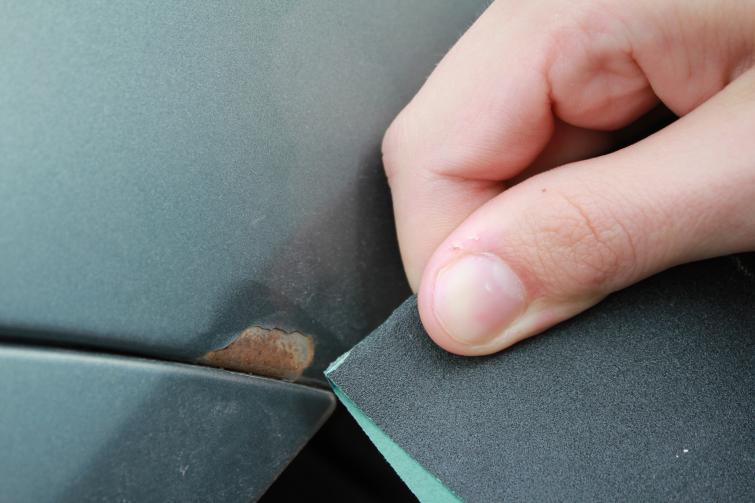
Repair of lost paint. What and how you can do it yourself - a guide
 Minor abrasions, loss of automotive paint, scratches and corrosive rashes are faults that cannot be avoided. However, many of them can be eliminated independently, quickly and at minimal cost. We suggest how to do it.
Minor abrasions, loss of automotive paint, scratches and corrosive rashes are faults that cannot be avoided. However, many of them can be eliminated independently, quickly and at minimal cost. We suggest how to do it.
However, before proceeding with the repair yourself, check if you can handle it. Remember that without a spray booth, oven, and professional paint supplies and equipment, only minor defects can be repaired. If your car body is severely rusted or bent, have it repaired by a painter.
– A complex renovation of one element costs about PLN 400-500. The price includes the dismantling of the upholstery, preparation for painting, and then painting, installation of the element in place and rearmament. In order to ensure that after the repair there is no difference in color shade in relation to neighboring elements, sometimes it is necessary to do shading, explains Slavomir Palka, a mechanic from Rzeszow.
What is shading? Let's say the back door needs to be varnished. In this situation, the varnisher repairs the damage and then completely covers it with base varnish, i.e. color. It also takes up a third of the front door and rear fender. Then everything is covered with a transparent varnish and polished. Then repairs are 30 percent more expensive, but the effect is incomparably better than when painting one element.
The ABC of self-painting - here's what we need:
Water based paper
Thickness is about 500-800. It will be used for leveling, lapping the primer just before applying the varnish. The price is approximately 1,5-2,5 zł per sheet.
Sandpaper (dry)
Thickness 80. Use for thorough cleaning of the most damaged areas. Thickness 240 will be needed for grinding the finishing putty. Thickness 360 is suitable for cleaning deep scratches. Prices, depending on the thickness, range from PLN 2,40 to 5,00 per linear meter.
Putty knife
We will use it to fill all the cavities. For deeper ones, we need putty with the addition of fiberglass. For finer putty without fibres. Materials from one of the popular companies in a package of 750 g cost about PLN 13-20.
Aerosol varnish (color of your choice)
It will be needed to complete our work. Gives a more pleasant effect than varnish in a spray can for application with a brush (without streaks and strokes). Price from PLN 11 for a pack of 150 ml.
Varnish in a jar with a brush
We will use it for small local touch-ups, less noticeable elements. Price from PLN 7 for a 10 ml jar.
Substrate
According to painters, acrylic, two-component primers are best suited. Ready-made sprays are most convenient for home use. A 150 ml aerosol can costs PLN 10. Chemically cured primer about PLN 25-40.
Washer
Necessary for thorough degreasing of elements before painting. In domestic conditions, this can be, for example, extraction gasoline.
Solvent
Often it is required to mix varnishes and primers.
Scratch-covering pencil
Gives only a temporary effect, is easily erased and does not fill the scratched area. Recommended for drivers who cannot handle lengthy repairs. The price is about 10 zł.
Light abrasive paste
The best remedy for removing small shallow scratches Price depending on the manufacturer PLN 6,5-30.
Low pressure gun
We connect it to the compressor. The varnish applied with it will look better than in an aerosol. The price is about 300 zł.
Here's how you repair damage:
cracked putty
– Sand the damaged element down to a bare sheet with 80 sandpaper.
– The place prepared in this way should be carefully primed with a primer varnish, preferably with a spray (unlike applied with a brush, you will get an aesthetic effect).
– After the primer has dried, apply putty to the missing varnish. After drying, rub with sandpaper "240".
– If you still can’t get a smooth surface, fill it with finishing putty and re-prime with a primer.
– Finally, apply a water-based paper “500-800” to the surface. Now you can apply varnish.
Scratch on paintwork
– You can try to remove light scratches with a light abrasive paste. The scratched fragment must be washed and dried. Then use a soft cloth to rub in the paste until it becomes glossy.
– If the scratch is deep and extends to bare sheet metal, the damaged area must be sanded with 360 sandpaper and then wiped with a washing machine (e.g. gasoline). Then we prime the place with a primer and after it dries we apply varnish.
Varnish worn on deck
- This malfunction most often occurs near thresholds, pillars and doors, i.e. where we most often hit and rub with our feet.
– If no corrosion is visible from under the worn area, it is enough to degrease it with gasoline and apply a new varnish.
Corrosion destroys the torn element
– We can remove small bubbles ourselves. The rusty element should be cleaned to a bare metal sheet with coarse sandpaper, and then coated with an anti-corrosion primer. After drying, paint with paint. If corrosion has damaged a large piece, the repair should be entrusted to the painter, who will insert a patch in place of the defect.